The Ultimate Travel Guide to Fes: Exploring Morocco’s Cultural Capital
Tucked away in the northeastern hills of Morocco lies Fes, a city where the past and present blend in mesmerizing harmony. Known as Morocco’s cultural and spiritual capital, Fes is home to the world’s oldest university, one of the largest car-free medinas on earth, and centuries-old traditions that still shape daily life. While cities like Marrakech often steal the spotlight, Fes offers a deeper, more immersive journey into Moroccan heritage one that rewards curious travelers with authenticity, beauty, and unforgettable moments.
Whether you’re wandering through the maze-like alleys of Fes el-Bali, admiring the craftsmanship of ancient madrasas, or sipping mint tea in a peaceful riad courtyard, Fes invites you to slow down and connect with the soul of Morocco. In this ultimate travel guide, you’ll discover everything you need to plan your visit from historical sites and local experiences to food, day trips, and practical tips all designed to help you make the most of your time in this timeless city.
A Brief History of Fes
Founded in the late 8th century by Idris I, the city of Fes is one of the oldest and most historically significant cities in Morocco. It quickly rose to prominence under Idris II, who established it as the capital and a religious and cultural center. Over time, Fes became a melting pot of Arab, Berber, Jewish, and Andalusian influences, shaping its architecture, culture, and spiritual identity.
By the 9th century, Fes had already welcomed waves of immigrants from Kairouan (Tunisia) and Andalusia (Spain), who brought with them advanced knowledge in science, trade, and craftsmanship. This period marked the founding of the University of Al Quaraouiyine in 859 AD now recognized by UNESCO and the Guinness World Records as the oldest existing university in the world.
During the Marinid dynasty in the 13th and 14th centuries, Fes reached its golden age. The city saw the construction of many madrasas (Islamic schools), mosques, and public buildings that still stand today, showcasing exquisite craftsmanship and intricate detail.
Though it eventually lost its status as Morocco’s political capital to Rabat, Fes remained the intellectual and spiritual heart of the country. Its ancient medina, Fes el-Bali, was named a UNESCO World Heritage Site in 1981, and remains one of the best-preserved historic towns in the Arab world.
In Fes, history isn’t just something you learn it’s something you live. The city’s layers of culture and tradition are still visible in its streets, crafts, and daily rhythms, offering travelers a rare chance to step back in time.
Top Things to Do in Fes
Fes is a city that rewards exploration. With every turn through its narrow alleys and bustling markets, you’ll uncover history, artistry, and culture. Here are the top experiences that no traveler should miss:
1. Get Lost in Fes el-Bali — The Ancient Medina
The beating heart of Fes is Fes el-Bali, one of the world’s largest and oldest medinas, and a UNESCO World Heritage Site. Dating back to the 9th century, it’s a sprawling, walled maze with over 9,000 narrow alleyways, countless shops, mosques, and riads.
You’ll encounter:
- Traditional souks selling spices, ceramics, lamps, leather goods, and rugs.
- Local craftspeople working in tiny, centuries-old workshops.
- Decorative fountains, hidden shrines, and ornate doorways around nearly every turn.
Tip: Don’t rely too much on Google Maps instead, enjoy the journey or hire a local guide who can navigate the maze and share stories you won’t find in any travel app.
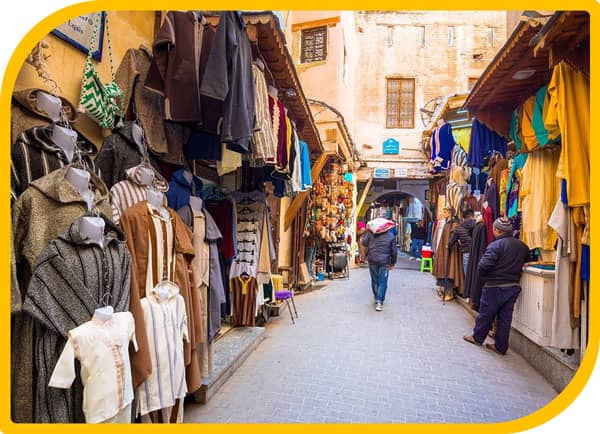
2. Visit the University and Mosque of Al Quaraouiyine
Established in 859 AD by Fatima al-Fihri, this is officially recognized as the oldest existing degree-granting university in the world. Though non-Muslims cannot enter the mosque, you can admire the beautiful architecture and peek inside from surrounding doorways or rooftops.
Highlights:
- A peaceful courtyard with an elaborate mosaic-tiled fountain.
- A stunning, green-tiled roof visible from above.
- The sense of standing next to an institution that predates Oxford and the Sorbonne.
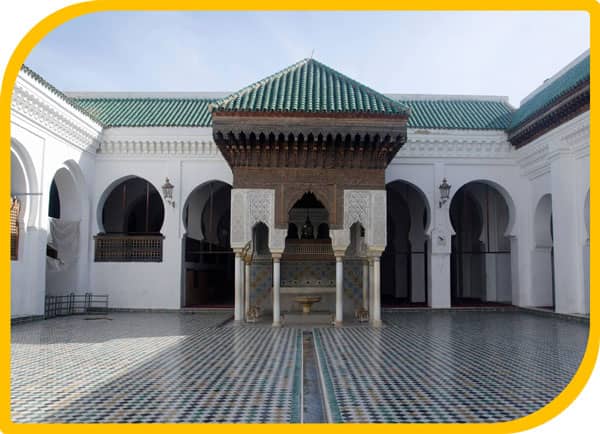
3. Witness Traditional Leather Making at the Chouara Tannery
Step onto a terrace overlooking the Chouara Tannery, where leather has been dyed and prepared using traditional techniques for over a thousand years. Workers stand waist-deep in colorful vats filled with natural dyes made from saffron, poppy, indigo, and more all processed with ancient methods involving lime and pigeon droppings (yes, really).
What to expect:
- A visually striking, multi-colored scene.
- The pungent scent, which is part of the authentic experience vendors usually hand you mint leaves to hold under your nose.
- Onsite leather shops, where you can purchase handcrafted slippers, bags, and jackets.
Tip: Visit in the morning for the most vivid colors and best photo opportunities.
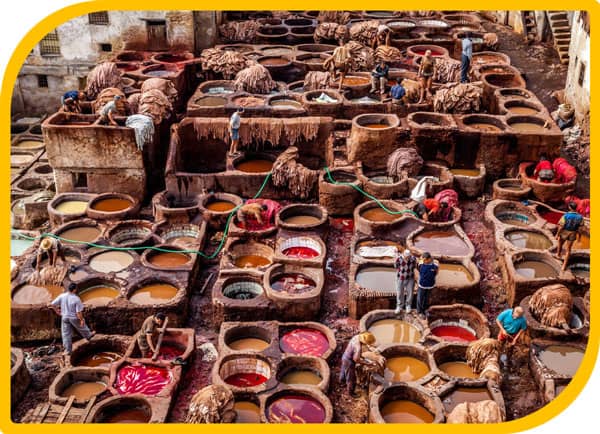
4. Marvel at Bou Inania Madrasa
One of the finest examples of Marinid architecture, this 14th-century madrasa (Islamic school) is a must-visit for its intricate artistry. It’s one of the few religious sites in Morocco open to non-Muslim visitors.
Don’t miss:
- Hand-carved cedar wood ceilings.
- Geometric zellij tilework in vivid blues and greens.
- A peaceful inner courtyard perfect for reflection and photography.
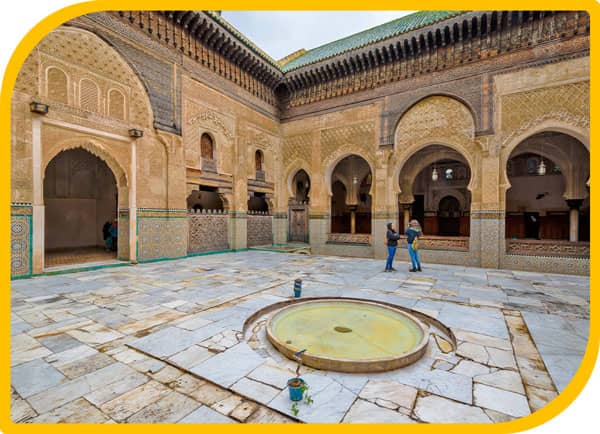
5. Admire the Royal Palace (Dar el-Makhzen)
Though visitors aren’t allowed inside the palace, the gilded doors of the Royal Palace are a major photo attraction. These massive bronze gates, flanked by intricate mosaics and carved wood, provide a glimpse of royal Moroccan style.
Nearby, the Jewish Quarter (Mellah) offers quiet streets, unique architecture with balconies, and a different side of Fes worth exploring.

6. Recharge in Jnan Sbil Gardens
When the medina becomes overwhelming, Jnan Sbil Gardens offer a tranquil retreat. These lush, manicured gardens date back to the 19th century and were restored in recent years.
Enjoy:
- Walking paths lined with palms and orange trees.
- Shaded benches and romantic bridges over small canals.
- Locals enjoying picnics, music, or quiet moments of rest.
Tip: It’s a great spot to bring a snack and unwind before heading back into the bustling streets.
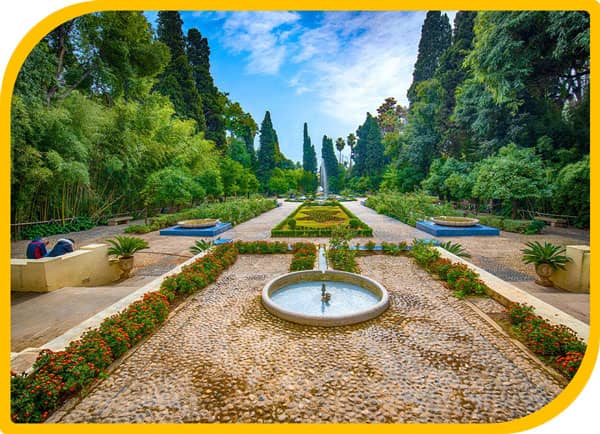
7. Shop for Artisanal Goods at Nejjarine Museum
Housed in a beautifully restored caravanserai, the Nejjarine Museum of Wooden Arts & Crafts celebrates Morocco’s long woodworking tradition. Located near the Nejjarine Fountain, the museum includes tools, furniture, and intricate wooden pieces from across the centuries.
Bonus: The rooftop café offers excellent views of the medina’s rooftops and minarets.
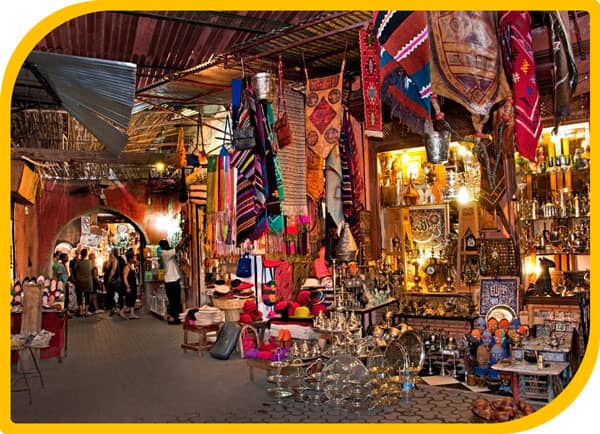
EXPERIENCE THE HEART OF FES THROUGH A CULTURAL JOURNEY
Step into the living history of Morocco’s oldest imperial city with our unforgettable Fes Cultural Tour. Lose yourself in maze-like medinas, visit ancient madrasas, sip mint tea in tranquil courtyards, and uncover centuries of craftsmanship and spiritual heritage woven into every corner.
Local Experiences & Cultural Immersion in Fes
To truly understand Fes, go beyond the landmarks and immerse yourself in the rhythms of daily life. The city offers endless opportunities to connect with Moroccan culture from age-old crafts to authentic cuisine and warm community traditions.
Take a Handicraft Workshop
Fes is famous for its artisanship. Many local studios and cooperatives offer short hands-on workshops, where you can learn traditional skills such as:
- Zellij tile making
- Brass etching
- Leather crafting
- Calligraphy or Arabic lettering
These experiences not only support local artists but also give you a unique souvenir made with your own hands.
Join a Moroccan Cooking Class
Food is at the heart of Moroccan hospitality, and Fes is one of the best places to dive in. Join a cooking class led by a local chef or home cook and learn how to prepare dishes like:
- Chicken or lamb tajine
- Freshly baked khobz (bread)
- Hearty harira soup
- Mint tea with all its ritual
Classes usually include a market visit, where you’ll shop for spices and ingredients alongside locals.
Visit Artisan Cooperatives
Unlike typical souvenir shops, artisanal cooperatives allow you to see how traditional goods are made. You’ll find:
- Weaving workshops in the medina
- Pottery studios just outside the old city
- Leather workshops that supply Morocco’s famous babouches (slippers)
You can speak with artisans, learn about their techniques, and ensure your purchases are fair-trade and authentic.
Attend a Cultural Evening or Festival
Depending on your timing, you might catch a traditional music concert, storytelling evening, or even a Sufi ceremony. The city also hosts the Fes Festival of World Sacred Music a globally renowned event featuring artists from across spiritual traditions.
Even outside festival season, many riads and cultural centers host weekly music nights or calligraphy demonstrations for visitors.
Walk with a Local Guide
Hiring a local licensed guide doesn’t just help you navigate the medina it gives you insights into daily life, customs, and stories you won’t find in guidebooks. Many guides grew up in the medina and have deep knowledge of its history, architecture, and communities.
Tip: Look for guides with government-issued badges or book through reputable platforms or your riad.
Where to Stay in Fes: Riads, Hotels & Neighborhood Tips
Fes offers a wide range of accommodations, from budget hostels to luxurious riads nestled inside ancient palaces. Where you choose to stay can shape your entire experience, especially in a city with such distinct neighborhoods.
Stay in a Traditional Riad in Fes el-Bali
If you want to experience the authentic soul of Fes, choose a riad a traditional Moroccan home with an inner courtyard in the heart of the old medina.
Why choose a riad?
- Beautiful architecture with tile mosaics, carved wood, and serene fountains.
- Personalized service and a more intimate, cultural atmosphere.
- Many riads offer rooftop terraces with panoramic views of the medina.
Tip: Some riads are hard to find within the narrow alleys. Book one that offers airport or taxi pick-up assistance and luggage help.
Modern Comfort Outside the Medina
If you prefer easier access and a quieter stay, look for hotels or guesthouses in:
- Fes el-Jdid – Near the Royal Palace, this area is calmer and still close to major sites.
- Ville Nouvelle – The modern part of Fes, with wider roads, cafes, and business hotels. Great for those who want Western-style comforts, nightlife, and shopping malls.
This area works best if you plan to explore the medina by day but prefer modern amenities and quicker transport options.
Accommodation Tips
- Book early during festival seasons or holidays, as rooms fill up fast.
- Look for riads that include breakfast, and check reviews to confirm if they serve traditional Moroccan dishes.
- Some mid-range riads and hotels also offer on-site hammams (traditional baths) or spa treatments perfect after a long day of walking.
Best Day Trips from Fes: Explore Beyond the Medina
While Fes itself offers plenty to see, the surrounding region is rich with natural beauty, history, and unique cultural experiences. Whether you’re into Roman ruins, mountain views, or peaceful countryside, these day trips from Fes are well worth adding to your itinerary.
Volubilis – Roman Ruins Among Olive Groves
Just an hour’s drive from Fes, Volubilis is one of the best-preserved Roman archaeological sites in North Africa.
- Wander through ancient mosaic-covered villas, basilicas, and triumphal arches.
- Take in stunning views of rolling hills and olive trees.
- Hire a local guide on-site for insightful historical context.
Tip: Combine Volubilis with a visit to Moulay Idriss for a full-day cultural outing.
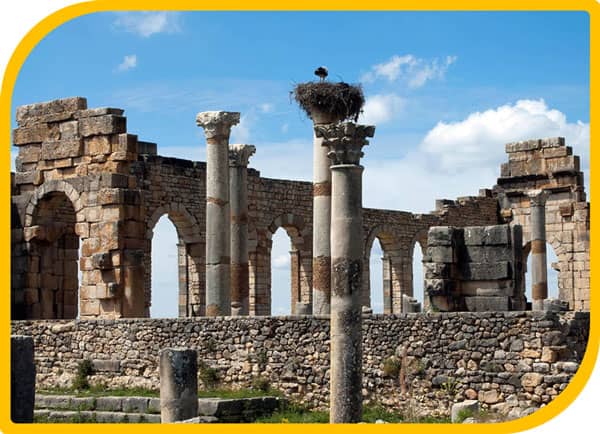
Moulay Idriss – A Sacred Hilltop Town
Just a few kilometers from Volubilis, Moulay Idriss Zerhoun is a charming, whitewashed town and an important pilgrimage site.
- Visit the tomb of Moulay Idriss I, founder of the first Moroccan Islamic dynasty.
- Enjoy panoramic views and a peaceful small-town feel.
- Explore winding alleys and sip mint tea at a rooftop café.
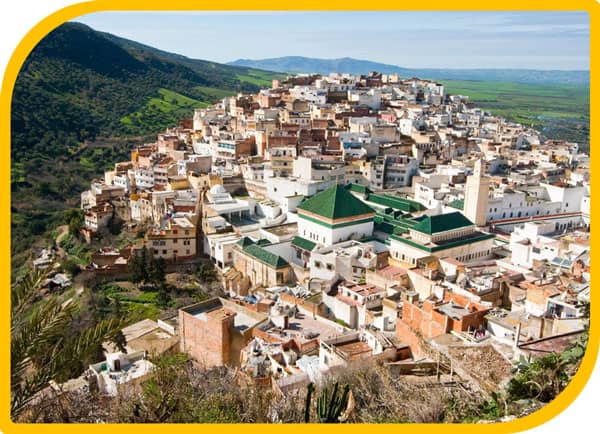
Ifrane – “Little Switzerland” of Morocco
Located in the Middle Atlas Mountains, Ifrane surprises many with its alpine architecture, clean streets, and cool climate.
- Great escape from the heat during summer months.
- Stroll through parks, lakes, and cedar forests.
- Visit Al Akhawayn University and the famous stone lion statue.
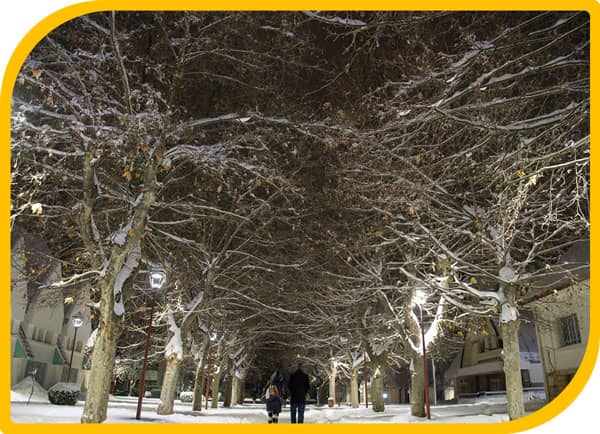
What to Eat in Fes: Iconic Dishes & Foodie Tips
Fes is a paradise for food lovers, known for its rich culinary traditions that blend Andalusian, Berber, and Arab flavors. Whether you’re dining in a family-run riad or snacking on the street, the city offers a mouthwatering variety of traditional Moroccan dishes.
Must-Try Traditional Dishes in Fes
- Bissara – A creamy split pea soup, typically eaten for breakfast with olive oil and cumin, served with fresh bread.
- Rfissa – A comforting dish made of chicken, lentils, and fenugreek served over shredded msemen (layered flatbread).
- Pastilla (Bastilla) – A savory-sweet pie made with layers of thin pastry, filled with pigeon or chicken, almonds, and spices, dusted with cinnamon and sugar.
- Harira – A hearty soup made with tomatoes, lentils, chickpeas, and meat especially popular during Ramadan.
- Tagine – Slow-cooked stews with meat, vegetables, and aromatic spices. Fassi tagines often include prunes, caramelized onions, and almonds.
Where to Eat in Fes
- Street Food Stalls – Try grilled meats, fresh olives, snails in spiced broth, and sweet Moroccan pastries like chebakia or sellou.
- Riad Dining – Many riads offer private, home-style meals cooked by in-house chefs ideal for tasting authentic local dishes in a peaceful setting.
- Mid-range Restaurants – Great balance between price and comfort, often with a rooftop view over the medina.
- High-end Dining – For gourmet Moroccan cuisine in beautiful Andalusian settings, try upscale restaurants tucked into restored palaces.
Don’t Miss: Mint Tea Culture
Mint tea, also called “Moroccan whisky,” is more than a drink it’s a sign of hospitality. You’ll be offered tea when shopping, visiting homes, or relaxing at any café. It’s typically made with:
- Green tea leaves
- Fresh mint
- Lots of sugar
Watch out for the dramatic pour from a height it’s all part of the tradition!
Foodie Tip: Ask if dishes are made fresh or reheated, especially in tourist areas. For the best experience, dine where locals go or follow your nose to the busiest stalls.
Shopping in Fes – What to Buy & Where to Bargain
Fes is a shopper’s dream, especially for lovers of traditional Moroccan crafts. The city’s bustling souks and markets offer everything from handmade ceramics to luxurious textiles. Knowing what to buy and how to bargain can turn your shopping experience into a memorable cultural adventure.
Top Souks & Markets to Explore
- Souk el Henna: Known for natural henna powders, traditional cosmetics, and beauty products.
- Souk el Attarine: Famous for spices, perfumes, and essential oils.
- Souk Seffarine: The metalworkers’ quarter, where you can find brass lamps, trays, and cookware.
- Leather Tannery Souks: Near the Chouara Tannery, this area offers authentic leather bags, slippers (babouches), and belts.
- Pottery and Ceramics Souks: Hand-painted plates, bowls, and tagine pots in vibrant colors.
Best Souvenirs to Bring Home
- Handwoven wool rugs and blankets
- Leather goods, including slippers and bags
- Colorful zellij (mosaic) tiles and pottery
- Argan oil and natural beauty products
- Traditional clothing like djellabas and kaftans
- Moroccan spices: saffron, cumin, cinnamon, and Ras el Hanout mix
Bargaining Tips
- Bargaining is expected in Moroccan souks, so don’t hesitate to negotiate.
- Start by offering about half the asking price and work your way up.
- Always remain polite and smile it’s part of the fun!
- If the price is too high or the seller is unwilling to budge, be ready to walk away.
- Buy from cooperatives or workshops to ensure fair prices and support local artisans.
Shopping Tip: Carry small bills and coins for easier transactions, and keep your belongings secure in busy markets.
Getting Around Fes: Transport Tips for Tourists
Navigating Fes can be an adventure in itself! The city’s mix of ancient alleys, busy streets, and modern neighborhoods means choosing the right transport option can save you time and hassle.
Exploring on Foot
The best way to soak up Fes’s atmosphere is by walking, especially inside the medina where cars can’t go. Expect narrow, winding alleys with plenty of surprises around each corner.
- Wear comfortable shoes, as cobblestones and uneven paths are common.
- Carry a map or use GPS offline apps since mobile signals can be spotty inside the medina.
Petit Taxis
Petit taxis are small, usually red, and ideal for short trips around the city.
- They have meters, but often drivers will negotiate a fixed price agree on a fare before starting your ride.
- Perfect for getting to and from the medina gates, train stations, or neighborhoods outside walking distance.
Grand Taxis
For longer trips between cities or rural areas, grand taxis (usually old Mercedes cars) are shared taxis that depart when full.
- They are budget-friendly but can be crowded.
- You can also book them privately at a higher price for more comfort and flexibility.
Bike and Scooter Rentals
Some tourists opt for bike or electric scooter rentals to explore wider areas or outskirts of Fes.
- Check with your accommodation for rental options and safety advice.
- Remember that medina streets can be crowded and narrow, so use caution.
Travel Tip: Always carry small change for taxis and confirm prices beforehand to avoid surprises. Keep your valuables secure when using any form of transport.
EXPERIENCE THE HEART OF FES THROUGH A CULTURAL JOURNEY
Step into the living history of Morocco’s oldest imperial city with our unforgettable Fes Cultural Tour. Lose yourself in maze-like medinas, visit ancient madrasas, sip mint tea in tranquil courtyards, and uncover centuries of craftsmanship and spiritual heritage woven into every corner.
When to Visit Fes – Best Times & Festivals
Choosing the right time to visit Fes can greatly enhance your experience. The city has a diverse climate and vibrant cultural calendar that offer unique charms throughout the year.
Best Seasons to Visit
- Spring (March to May):
Ideal weather with mild temperatures and blooming flowers. Perfect for exploring the medina and outdoor attractions without the summer heat. - Autumn (September to November):
Another pleasant season with warm days and cooler evenings, great for sightseeing and day trips to the mountains or desert.
Summer (June to August)
Summers in Fes can be quite hot, with temperatures often reaching over 35°C (95°F). If you visit during this time:
- Plan outdoor activities early in the morning or late afternoon.
- Stay hydrated and take breaks in shaded areas or air-conditioned cafes.
Winter (December to February)
Winters are mild but can be chilly at night, especially in the medina where buildings are stone.
- Good for fewer crowds and lower prices.
- Bring layers and a warm jacket for evenings.
Must-See Festivals in Fes
- Fes Festival of World Sacred Music (June):
A renowned cultural event that brings together artists from around the world for performances in historic venues. - Moulay Idriss Moussem (August):
A religious pilgrimage near Fes honoring Moulay Idriss I with traditional music, markets, and ceremonies. - Date Harvest Festival (October):
Celebrated in nearby Erfoud, perfect if you plan side trips and want to experience local harvest traditions.
Travel Tip: Book accommodations and tours early if visiting during festivals, as demand increases sharply.
Practical Travel Tips for Fes Visitors
To make your trip to Fes smooth and enjoyable, here are some handy tips covering everything from safety to cultural etiquette.
Safety and Health
- Fes is generally safe for tourists, but always keep an eye on your belongings in crowded areas to avoid pickpocketing.
- Drink bottled water and avoid ice cubes in drinks to prevent stomach issues.
- Carry a small first-aid kit with basics like band-aids, antiseptic, and any personal medications.
Dress Code and Etiquette
- Morocco is a Muslim country with conservative values, so dress modestly, especially in religious or rural areas.
- Women should consider wearing clothes that cover shoulders and knees to respect local customs.
- When visiting mosques, non-Muslims are usually not allowed inside, but you can admire the architecture from outside.
Language Tips
- The main languages spoken in Fes are Arabic and Berber, but French is widely understood.
- English is increasingly common in tourist areas but learning basic Arabic or French greetings can go a long way.
- Polite phrases like “Shukran” (Thank you) and “Salam” (Hello) are appreciated.
Money and Payments
- The Moroccan Dirham (MAD) is the currency. Cash is king in Fes, especially in souks and small shops.
- ATMs are available, but it’s wise to carry enough cash for daily expenses.
- Credit cards are accepted in many hotels and restaurants but less so in markets.
Connectivity and Internet
- Free Wi-Fi is common in hotels, cafes, and some public places.
- Consider buying a local SIM card for better coverage and data plans if you need constant internet access.
- Offline maps apps can be very helpful inside the medina.
Travel Tip: Always keep a copy of your passport and important documents separate from the originals.
Final Thoughts
Fes is a city where history, culture, and vibrant daily life blend into an unforgettable experience. From wandering its ancient medina and marveling at stunning architecture to savoring traditional dishes and shopping for unique crafts, Fes offers something truly special for every traveler. With its warm hospitality and rich heritage, it’s no surprise that visitors return time and again to Morocco’s spiritual and cultural heart.
Ready to discover Fes for yourself? Pack your bags and immerse yourself in the magic of this timeless city!

